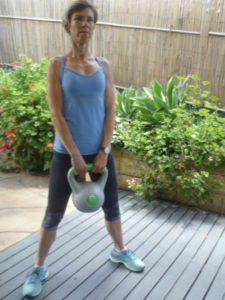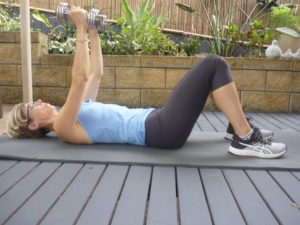Pelvic floor safe exercise
A 10 step guide to pelvic floor safe exercise
Simple, practical tips to modify an exercise program to be pelvic floor safe.
1. Avoid heavy lifting
Keep your weights within a manageable range. Never lift heavy weights that make you strain or inclined to hold your breath. If you have pelvic floor problems, you must keep your resistance to a minimum until your pelvic floor muscle condition has improved. Avoid lifting weights from ground level if possible; instead, aim to lift from waist height.
2. Use your pelvic floor muscles
Lift your pelvic floor muscles prior to and during your resistance exercises, and relax fully between sets or repetitions. The goal is for your pelvic floor to be working immediately before and as you lift/lower/push or pull any load. (click here to read more about pelvic floor)
3. Lift with good posture 
Maintain the normal inward curve in your lower back during every lift/lower/push/pull exercise you do, regardless of whether you are sitting, standing or lying on your back. This will promote the protective activity of your supportive deep abdominal and pelvic floor muscles and discourage the activity of your strong outer abdominal muscles.
4. Exhale with every effort
Never hold your breath or pull your stomach in strongly during your exercise as this increases the downward pressure on your pelvic floor. Breathe out with every effort, whether it is a lift, push or pull, to reduce the likelihood of straining your pelvic floor.
5. Choose supported positions
Your pelvic floor will be under less strain if you perform your resistance exercises sitting or lying down wherever possible. Sitting on an exercise ball is an excellent
option while you perform your strength exercises. It will promote the activity of your deep abdominal muscles, support your pelvic floor, decrease the likelihood of symptoms as you exercise, and make it easier to feel your pelvic floor muscles working.
6. Keep your feet close together
You will find it easier to activate your pelvic floor muscles when your feet are close together and your pelvic floor openings are less exposed. If you  are performing a standing resistance exercise, try to keep your feet no wider than hip width apart rather than wide-leg standing positions. Hip width means that your knees should be approximately fist width apart.
are performing a standing resistance exercise, try to keep your feet no wider than hip width apart rather than wide-leg standing positions. Hip width means that your knees should be approximately fist width apart.
7. Strengthen gradually
Start using very light resistance and pay attention to performing the exercise correctly to reduce your risk of injury. Gradually increase your load when you are very confident of your technique and when you have good pelvic floor and abdominal muscle control.
8. Take care when fatigued or injured
When you are very tired, unwell or have lower back pain, your pelvic floor and deep abdominal muscles may not work as effectively and you will be more prone to symptoms and injury. Take a break and return to resistance training when you have recovered.
9. Rest between sets
Rest for a couple of minutes between each set of exercises you perform. This gives your muscles (including your pelvic floor muscles) time to recover before your next lift.
10. Avoid aggravating exercises and machines
Listen to your body when exercising. If your symptoms are worse with a specific exercise, modify that exercise or leave it out of your program and perform another exercise to strengthen the same area.
Pilates:
Regular Pilates practice can help strengthen pelvic floor muscles as well as your deep “core” muscles. This helps support your back and can result in reduced back pain, injury prevention and great posture.
Click here to try a Pilates class

This guide has been reproduced with kind permission from Michelle Kenway, physiotherapist and author of Inside Out.
